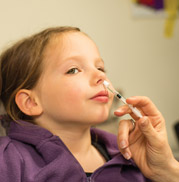 A new research paper has been published by UK doctors reflecting on the successes and challenges of delivering flu vaccines to children.
A new research paper has been published by UK doctors reflecting on the successes and challenges of delivering flu vaccines to children.
Vaccinating 9 million school children in 6-8 weeks (from October to December) is a major task, requiring cooperation between health services, teachers, children and their families.
Children & flu
Children and older people are at particularly high risk of complications if they catch the flu.
The protective efficacy of flu vaccination in older people is often lower than in the rest of the population because the immune system wanes with age.
Children play an important part in the ‘transmission’ of the virus in the community – i.e. they catch it and spread it to others, including older and vulnerable individuals.
In 2012, the expert committee that advises the UK government on immunisation programmes recommended that its seasonal flu campaign be extended to include healthy children and adolescents aged 2 to 17 years.
In the winter of 2013-2014, GPs began vaccinating children aged 2 and 3 years. A number of pilot projects were also conducted in primary schools across England, Scotland, Wales and Northern island, along with a single pilot in a secondary school in England.
The paper looks at everything from the practical aspects of supplying, storing and distributing vaccines to training staff and communicating with parents.
It could, say the authors, help other countries thinking of rolling out a similar programme.
Read: The ethics of immunising healthy children against flu
Communication and convenience
As this was a new programme, getting the message out to parents was essential.
For pre-school children, invitation letters and text message reminders were sent; evening clinics were arranged and information was shared via posters and local radio stations. In schools, the vaccine was generally well accepted by children and parents.
The fact that a nasal vaccine was used rather than an injection may have helped. “Most parents considered the nasal vaccine to be better than injection,” according to the paper.
Many of the school-based pilot projects issued certificates and stickers which were popular with children.
The authors also report that their experience tallies with earlier research showing children prefer the intranasal vaccine used in the UK childhood flu vaccination programme.
“The first year pilot programme demonstrates that a childhood immunisation programme, undertaken in schools, GP surgeries, and across different healthcare settings, is feasible and can achieve a good level of coverage,” says the authors.



